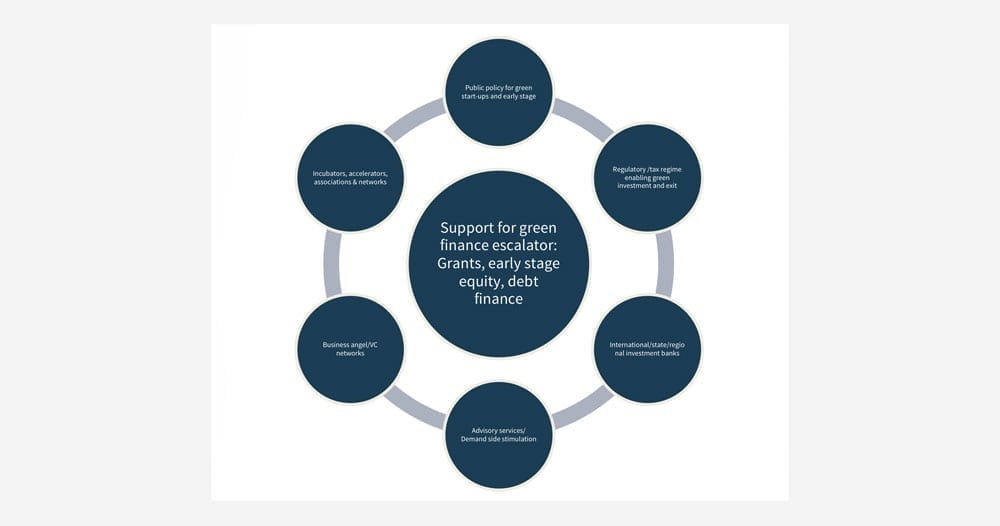Filling the finance gap for early stage green innovations
The green economy of the future will be shaped by the innovative enterprises emerging today. But picking the winners of tomorrow is notoriously difficult. Small entrepreneurial businesses wanting to contribute to the transition to a low carbon and sustainable economy may have the desire to scale up, but without the trading track record or the assets for collateral, they may be turned down by banks and other investors.
It is this ‘finance gap’ for early stage green innovation that has been a focus for a research project within the ESRC Centre for the Understanding of Sustainable Prosperity (CUSP) and a new paper from Middlesex University researchers in a special issue of the peer review journal Current Opinion in Environmental Sustainability prepared for the Intergovernmental Panel on Climate Change (IPCC) Sixth Assessment Cycle and Special Report on Global Warming. This paper, with my colleagues Robyn Owen and Geraldine Brennan, examines the role of government in enabling investment for a transition to a low carbon economy.
Our paper explores the need for different forms of finance to be available at different stages of growth. We call this the ‘finance escalator’. For all start-ups, there are real challenges with survival and scaling up. Most rely on their own funds, putting in their time for free or with help from family and friends. Grants from government can also play a crucial role at this stage.
As early stage businesses cannot get access to bank lending or other forms of investment available to large established businesses, the next stage of the escalator relies on forms of equity finance from investors willing to invest their own money for a stake in the business. There has always been involvement of these ‘business angels’ in early stage businesses and there is increasing interest in sustainable, social and impact investing. However, there are can be a lack of longer horizon funding that is needed for the green economy.
There are examples of public sector support for increasing the access to longer horizon sustainability focused equity funding. Examples of this kind of support include the Canadian Nova Scotia Clean Technology Fund, established in 2011 and investing in bioscience and smart grid firms, or the UK Innovation Investment Fund helping other funds to provide longer horizon finance in a range of sectors including energy. We also find some support for crowd funding platforms encouraging equity investment in green innovations. Public funds are also found encouraging lending institutions to invest in green enterprises, with a range of Green Investment Banks being funded around the world. A previous blog explores the issues around the establishment and sale of the UK’s Green Investment Bank.
These government funds aim to support specific businesses but also to encourage other finance providers to invest in these new green innovative sectors. This ‘demonstration effect’ is evident in recent discussions about the UK Green Investment Bank and its role in encouraging others to follow their investment into the offshore wind energy sector.
Our paper finds that there are more examples of public funds for assisting finance for the more established businesses, but on-going gaps for the early stage equity investment – those businesses that the banks feel are too risky. The short term mind-set of investors makes these innovative businesses even less appealing and the global financial crisis exacerbated an already large finance gap.
The finance gap cannot solely be blamed on the investment providers. We also show that there can be a lack of investable propositions from these early stage innovative green businesses. There are therefore a range of publicly funded programmes looking to improve the ‘investment readiness” of these businesses. There also needs to be a conducive policy context, supportive networks and access to ideas and mentors. International experience shows the importance of bringing all these factors together along side increased supply of investment funds. This green finance ecosystem approach shows that no single element can work on its won. It is the interaction and complementary approaches that are likely to lead to success.

Just as we need innovation in green technology or services, we also need innovation in investment for early stage businesses. The public sector may need to contribute funds to such innovations focused on the common good. Where we have that innovation, we also need rigorous evaluation so we can know what works in what circumstances. Where there is public investment there is a need to show the additional impact of such funds, beyond what might have happened with a reliance on the private sector.
Perhaps we cannot pick the green entrepreneurial winners of tomorrow but we can be better at picking the winning ways of using public funds to drive a green economy. This is needed to ensure precious public investment has the biggest impact on the transition to a low carbon economy and promoting sustainable prosperity.




